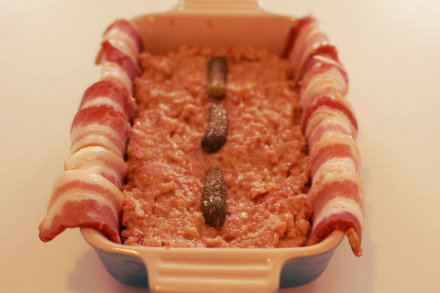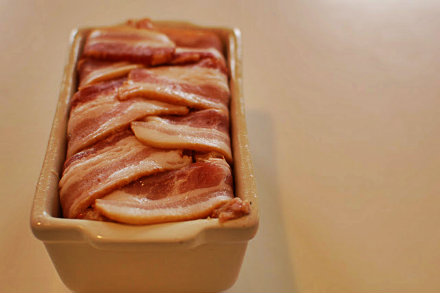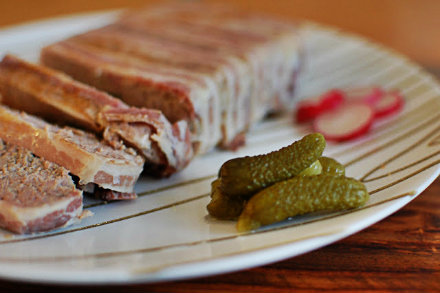
Months ago I was sitting with my friend Audrey Sussman on her porch. We were drinking iced tea and enjoying the sun, probably having a meeting of some sort on recipes. But then she changed the subject, as if inspired, and she asked, “Do you want to make pâté?” She used kind of a secret tone, like we were going to smoke behind the barn or steal lipsticks from the CVS. “You know, at Christmas,” she added. It was August. I’ve always been an easy one to convince, although I never was a lipstick stealer. (The Jewish guilt and fear of being caught stopped me.) But I jumped on that one without a beat. The fall stretched ahead of us, but I knew that come Christmas, I’d be inducted into the pâté-making society. Jean-Francois, who owns the little shop in which I’ve been working, says that pâté peaks on the fifth day. It needs to meld, to mature, and come together so that every bite has married every other, so that one slice… is perfect.

Daily Pâté(adapted by Audrey from the original New York Times cookbook) This recipe makes an excessive amount of pâté, which I think is exactly enough. It will fill 2 standard loaf pans, or several smaller ones. Make it with a friend, and then you can share. 3/4 pound pork fat (you can get this from a butcher–we also used some duck fat in here which I think worked really well) 3/4 pound fatty prosciutto rind or more pork fat or bacon 1 pound ground veal 1 pound ground pork shoulder 1 pound ham, cubed 1/2 pound chicken livers 8 cloves garlic, minced 1/4 cup heavy cream

3 eggs 1/2 cup cognac 4 teaspoons salt 2 teaspoons white pepper 1/2 teaspoon allspice 1/2 teaspoon cinnamon 1/2 cup flour Optional: cornichons Preheat the oven to 400 degrees. Line the pans with the prosciutto rind, pork fat, or bacon. Combine the 1/2 of the remaining pork fat with the veal, pork shoulder in the bowl of the food processor. Pulse to combine, and transfer to a mixing bowl. Combine the rest of the pork fat with the ham in the food processor. Pulse to combine. Add the chicken livers, garlic, cream, eggs, cognac, and 1/3 of the veal mixture to the bowl of the food processor. Combine until you have a uniform and relatively smooth mixture. Transfer to the mixing bowl with the rest of the veal mixture. Add the seasonings and flour, and mix with your hands.

Fill half of each pan with the mixture, then add sliced cornichons if you like. Top with the rest of the mixture, and pack it in. If you are using bacon to line the pans, fold it over the top of the pâté. If you are using pork fat or prosciutto rind, pack it around the pâté. The goal is to create a seal around the meat with the fat. Cover each pan with a double layer of aluminum foil and set them into a baking sheet with a high lip or a 9×13 baking pan. Fill the pan halfway with water, and bake until the pâté reaches an internal temperature of 160 degrees. This will vary depending on the size of your pans, but start checking after 1 1/2 hours. Remove the pâtés from the oven, let them cool, and refrigerate. For the first day in the refrigerator, set a weight, such as a rock or a water bottle on the aluminum foil. This presses the pâté to draw any fat out of the center. Pâté that is still in its sealed fat layer is good for up to 10 days or so. — Reprinted with permission from Eatingfromthegroundup.com [1]. All text and photos copyright 2008-13 by Alana Chernila.









